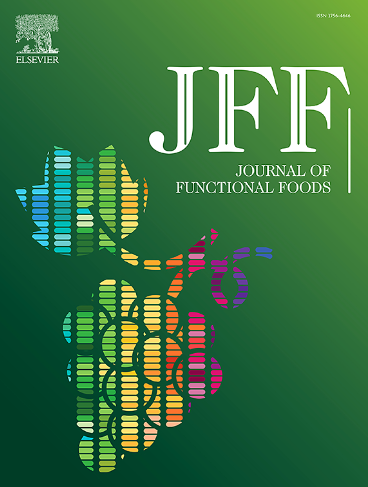Abelmoschus esculentus prevents obesity-related metabolic disorders by increasing the activity of brown adipose tissue and white adipose browning via activating AMPK
IF 4
2区 农林科学
Q2 FOOD SCIENCE & TECHNOLOGY
引用次数: 0
Abstract
Obesity is a global health concern with high metabolic disease risk. Boosting the activity of brown adipose tissue (BAT) and white adipose tissue (WAT) browning combats against metabolic disorders. Abelmoschus esculentus (AE) was reported to improve metabolic disorders, but the mechanism remains unclear. This study aims to investigate AE's therapeutic mechanism in metabolic disorders. We explore the effect of AE on rats with high-fat diet and the primary adipocytes isolated from rat adipose tissue. In rats, the results showed that AE effectively ameliorated metabolic disorders induced by HFD, enhanced BAT activity, and WAT browning. In addition, AE significantly increased the AMPK phosphorylation in rat adipose tissues and primary adipocytes. Inhibition of AMPK in primary adipocytes abolished AE's beneficial effects, whereas AMPK activation significantly potentiated AE's effect. It demonstrates AE alleviates obesity-related metabolic dysfunction via AMPK-mediated activation of BAT and WAT browning, suggesting AE's therapeutic potential for metabolic disorders management.

黄斑沙鼠通过激活AMPK增加棕色脂肪组织的活性和白色脂肪褐变,从而预防肥胖相关的代谢紊乱
肥胖是一个具有高代谢疾病风险的全球性健康问题。提高棕色脂肪组织(BAT)和白色脂肪组织(WAT)的活性,可以对抗代谢紊乱。据报道,沙鼠(Abelmoschus esculentus, AE)可以改善代谢紊乱,但其机制尚不清楚。本研究旨在探讨AE治疗代谢性疾病的机制。我们探讨AE对高脂饮食大鼠及从大鼠脂肪组织中分离的原代脂肪细胞的影响。在大鼠实验中,结果显示AE能有效改善HFD引起的代谢紊乱,增强BAT活性和WAT褐变。此外,AE显著增加了大鼠脂肪组织和原代脂肪细胞中AMPK的磷酸化。在原代脂肪细胞中抑制AMPK可消除AE的有益作用,而激活AMPK可显著增强AE的作用。研究表明,AE通过ampk介导的BAT和WAT褐变激活,减轻了肥胖相关的代谢功能障碍,表明AE在代谢紊乱管理方面具有治疗潜力。
本文章由计算机程序翻译,如有差异,请以英文原文为准。
求助全文
约1分钟内获得全文
求助全文
来源期刊

Journal of Functional Foods
FOOD SCIENCE & TECHNOLOGY-
CiteScore
9.60
自引率
1.80%
发文量
428
审稿时长
76 days
期刊介绍:
Journal of Functional Foods continues with the same aims and scope, editorial team, submission system and rigorous peer review. We give authors the possibility to publish their top-quality papers in a well-established leading journal in the food and nutrition fields. The Journal will keep its rigorous criteria to screen high impact research addressing relevant scientific topics and performed by sound methodologies.
The Journal of Functional Foods aims to bring together the results of fundamental and applied research into healthy foods and biologically active food ingredients.
The Journal is centered in the specific area at the boundaries among food technology, nutrition and health welcoming papers having a good interdisciplinary approach. The Journal will cover the fields of plant bioactives; dietary fibre, probiotics; functional lipids; bioactive peptides; vitamins, minerals and botanicals and other dietary supplements. Nutritional and technological aspects related to the development of functional foods and beverages are of core interest to the journal. Experimental works dealing with food digestion, bioavailability of food bioactives and on the mechanisms by which foods and their components are able to modulate physiological parameters connected with disease prevention are of particular interest as well as those dealing with personalized nutrition and nutritional needs in pathological subjects.
 求助内容:
求助内容: 应助结果提醒方式:
应助结果提醒方式:


